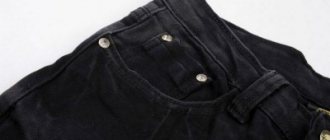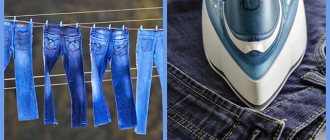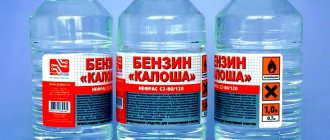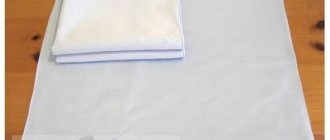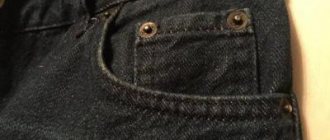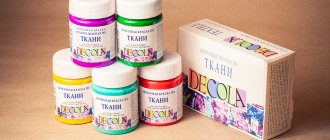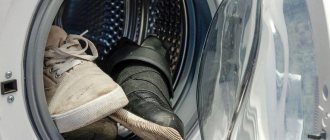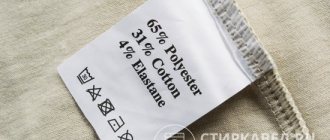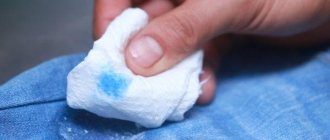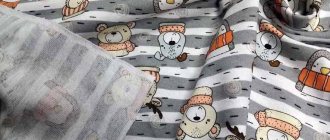Share on social media networks:
Nowadays, no wardrobe is complete without jeans, because they are the most comfortable and popular clothing. But it has one significant drawback: over time, jeans lose their original color and become faded. You can, of course, entrust your favorite pants or skirt to dry cleaning professionals, but this problem can be easily and simply solved on your own. You can return the color to its former brightness; a great idea is to dye your jeans in the washing machine. It's very simple and won't take much time or effort, plus it's absolutely safe for both your washing machine and your clothes. The main thing is to choose the right color. So, let's talk about how to dye clothes in the washing machine.
Preliminary tips before staining
Before embarking on such a responsible task, you need to know about all the possible consequences. And be sure to follow these recommendations to avoid unexpected effects.
In general, we would advise you not to get excited, but to check the result on some old thing. It’s easy to ruin it, but it will be impossible to wash the paint if something doesn’t work out.
So, what you should understand before coloring:
- Only cotton fabric, wool or linen can be dyed ideally, while the rest can simply be taken in pieces. Unfortunately, there are now often cases when the label states that it is 100% cotton, but in reality it turns out completely differently. Therefore, if you are not completely sure of the composition, try to pre-dye a small piece of fabric, specifically from this product.
- You can only dye a well-washed item, and put it in the machine wet. Otherwise, the paint will lie unevenly.
- Paint cannot completely cover all stains. If your stain is much lighter than the main fabric, then it will be visible in any case.
- Painting a white thing black is unlikely to work. It will turn out dark gray, at best. To achieve deep black, you will need more than one paint job.
- You must understand that the painted item will then fade. And it is not recommended to wash it in a machine, with other things, until five washes. Only after this will she stop getting dirty.
- Synthetics are almost never painted, no matter what paint manufacturers say. But there are rare exceptions, of course. Therefore, try on a piece of fabric to avoid a “spotty” result.
- The exact color indicated on the packaging only comes out when you dye it on a white item. If you apply it to other shades, the result will be slightly different. But, at least in the declared color scheme! In general, almost roulette.
- As a rule, the threads used to stitch the fabric are made of synthetics, as they are stronger and more durable. And be prepared for the fact that the main fabric will be dyed, but the threads will remain the same color. So, figure out in advance how they will be combined later.
- Never add conditioner during the painting process! The paint will come out in spots.
- Rust stains are very difficult to paint.
- Denim material is dyed on both sides
See also -
How to turn on a washing machine
About the washing machine itself
After you have dyed your clothes, there is still a problem with the washing machine, because there are paint particles left in it. To get rid of them, run the machine idle.
Important! Immediately after painting, do not wash light-colored items.
Many housewives are worried about their washing machine. Will fabric paint ruin it? What is the best way to dye jeans with fabric dye - in the washing machine or by hand?
- Nothing will happen to the machine, the paint is safe for parts.
- But it is not recommended to dye by hand, since in this case the paint is distributed unevenly across the fabric, and the dishes in which the dyeing is done will be damaged.
Important! If you generally liked the result of the dyeing, but there is still something missing in the design of the product, look through our selection of interesting ideas on how to decorate jeans.
Step-by-step painting technology
Well, let's get down to the most important thing. You have already washed the item, it is damp. Now you must dilute the coloring composition, based on the manufacturer's recommendations. Many manufacturers recommend adding a couple of tablespoons of table salt. If it says so, be sure to add it. If not, then this is not necessary, and they forgot to write.
If you do not need to mix with salt, then simply pour the paint into the drum. Run the long wash cycle at 40-60C. That's all! Then, at the end of the cycle, put it in a regular wash, using only cold water, adding powder and conditioner. This temperature regime will fix the coloring result.
After this, we take out the item and run the machine again. You can put some old rags, or you can put empty ones. This is necessary to collect the remaining paint from the drum and completely clean it. Also, we do not recommend washing white items immediately after this procedure, even after cleaning. God takes care of those who are taken care of, as they say...
As you can see, dyeing jeans in a washing machine is a simple thing.
How to properly dye jeans using Blue and potassium permanganate?
The choice of powder formulations is huge. They are easy to use and highly durable. Price category from 20 rubles per package.
Manufacturers of more expensive modern dyes have eliminated this shortcoming, and we can afford bright shades.
Dissolve a packet of coloring powder in 0.5 liters of water, in a separate container (glass, ceramics) with warm water, stir thoroughly.
Strain the solution. To do this, you can use: a piece of old organza, tulle, gauze, cotton wool, which will hold undissolved particles.
Place clothes, prepared solution in a large saucepan and add water so that the liquid covers the pants.
Add salt or soda if the instructions require it. Bring to a boil and keep on fire for an hour.
Don't forget to stir and turn over. Otherwise the color will lie unevenly.
Leave the jeans to cool in the dye. Wash in warm, then cold water.
We fix the result with vinegar for at least 30 minutes. Fixative: vinegar 9% (3 tbsp per 1 liter of water) or vinegar essence 70% (2 tbsp per 1 liter of water).
Whiteness helps solve several problems at once:
- Complete whitening
- Lightening by tone,
- Partial (amber, spotted patterns),
- The "varenki" effect.
Depending on what kind of lightening we are trying to achieve, we keep the item in an aqueous solution of whiteness for 10 minutes to 1 hour.
If you partially dip the clothes into white, for example, only from the bottom, we get a color transition effect (ombre). Tie several strong knots on the legs and after processing, an unusual ornament will appear.
Our parents independently “cooked” cool jeans with whiteness, which became a cult attribute of the 80s and early 90s.
Coloring depends on your wishes. If you need deep blacks, use high-quality powder dyes; if you need dark grays, lighten them with white.
Dyes that can be purchased to change or restore the shade of jeans can be divided according to the following parameters:
- composition;
- structure;
- packaging;
- origin;
- purpose.
- The composition of textile dyes is varied. The components contained in the substance affect its durability and brightness. Some elements are capable of changing or transforming the structure of the fabric to which they are applied. For example, acrylic gives the canvas additional strength and density.
- The structure or form of release of the dye is responsible for the method of its application. There are three main types:
- powder;
- liquid;
- aerosol;
- pasty suspension;
- natural look.
- The packaging of the paint ensures shelf life and ease of application. It can be paper, polyethylene, in the form of a tube, balloon or jar.
- By nature, dyes can be divided into two main groups:
- Natural. An environmentally friendly method of dyeing textiles using plant and food ingredients. They are often used in their natural form, as well as in the form of juices and decoctions.
- Synthetic. Elements obtained by chemical means. They are often extracted during the technological processing of various substances using the production method.
- Depending on the purpose, the paint can be applied with a brush to local areas or evenly distributed over the entire surface of the canvas.
- The choice of dye depends on the goals and needs of the person.
The simple and affordable composition is ideal for restoring the color of classic denim items. The drug is available for purchase in hardware stores. Please read the instructions carefully before use.
Please note that the substance is suitable for tinting blue items. It will not be possible to completely change the shade with this help. The durability of the bluing is not high, so after a while you will have to repeat the procedure.
Another point that cannot be neglected is that during the washing process after dyeing, the pigments from the fabric will be washed out, so it is better to wash the item separately from others or with clothes of the same color.
To make the result last longer, dyed jeans require careful care.
It is better to wash your pants by hand, in warm but not hot water. Preference should be given to laundry soap or soap nuts rather than aggressive powders. Before washing, jeans should be turned inside out.
We invite you to read: Planting grape cuttings for the winter
Important! Dyed jeans should be washed separately from other items.
The product should not be pre-soaked - the color will come off along with the dirt.
Under no circumstances should you dry your jeans in direct sunlight, as this will cause the color to fade. Leaving clothes on a radiator runs the risk of yellow stains and dull colors. Drying on clotheslines in a well-ventilated area is suitable.
By following these simple recommendations, you can dye your jeans at home and enjoy the rich colors for a long time.
- you can create fuzzy, blurry boundaries of color transitions with aniline;
- to fix the dye, tragacanth glue is added to the aniline in a ratio of 1:3, or the jeans can be pre-soaked in gelatin;
- Any drawing is created with acrylic-based paints. They are applied to a dry item along pre-drawn contours. The paint dries for 10-15 hours, and then the jeans are smoothed with an iron.
They are more often used in screen printing, but for manual work there is a fluorescent dye based on a phosphor.
- Jeans are cleaned of dirt and washed.
- The first layer of the image is applied with a synthetic brush.
- After the first layer has completely dried, the second and subsequent layers are applied.
- After applying the last layer, the jeans dry for 2-3 hours.
To make the drawing look more impressive, light colors are used as a basis. The glow dye is charged from sunlight, which accumulates in 20-30 minutes.
Fabric paints
Hair dye
This method is a little unusual, but it gives excellent results when painting at home, the shade is bright and very saturated. To achieve the desired result, you need to prepare 2 packages of hair dye of the selected shade. The paint is diluted in the standard way and added to a basin of water; it is important that the liquid completely covers the item being painted.
The denim item must be left in the solution for two hours for best dyeing. After completing this process, the jeans must be rinsed in water at room temperature for the first time, and the second time in cool water with the addition of salt and vinegar. Be sure to wash your jeans in the washing machine using regular powder without bleaching. Dry the product in a well-ventilated area.
Blue
To achieve high-quality blue dyeing at home, you should follow the following key steps:
- Blue must be diluted in cold water, after which it can be mixed with warm water. You should act strictly according to the instructions; some of the product works during the washing process, and the other during rinsing.
- Pre-washed and ironed jeans are dipped into the solution; if the product is wrinkled, the coloring will be uneven. The process should be smooth, with the jeans slowly immersed in the prepared solution to obtain an even color.
- Depending on the brightness of the required shade, the jeans remain in the solution from 2 to 12 hours; with the maximum time, an extremely saturated shade of blue is obtained.
- Finally, the product must be rinsed several times, changing the water each time; vinegar is added to the latter to fix it.
White
Such a product can be classified not so much as coloring, but rather as lightening the product. For several decades, whiteness was used to produce fashionable “varenok”; with its help, the effect of a faded bluish tint appeared on the product.
Jeans of this color can be obtained by following the following algorithm:
- In 10 liters of water you need to dilute 250 ml of white, which can be purchased at any hardware store.
- Place the jeans in a fully immersed bucket and boil for about 15-20 minutes depending on the thickness of the fabric.
- During the entire process, it is necessary to prevent the jeans from rising above the surface of the water and be sure to carry out all painting work in a well-ventilated area.
In order to change the color of your favorite jeans, you need to choose the optimal dyeing method, depending on the dye itself and the desired result. Jeans can not only be completely dyed, but also use unusual techniques that will give the product an original appearance; these options include coloring, which looks especially good on white jeans. To achieve the desired result, the following two methods are mainly used.
Washing machine
To avoid such consequences, you must carefully read the instructions on the packaging of coloring components and do not increase the recommended percentage of dye.
- The item being prepared for dyeing must first be washed and dried, this will help the color to lie most evenly.
- Dilute the coloring composition in water if the instructions require it and be sure to get rid of any lumps from the powder products.
- Select the maximum temperature allowed for denim and run the wash cycle for a longer duration. The solution, depending on the recommendations, is poured either directly into the drum or into a special compartment.
- After washing, immerse the dyed jeans in salted water for half an hour, then run an additional wash as usual. This procedure will help get rid of excess dye and make the color more even.
- After finishing the washing machine, you must carefully inspect the parts for staining and, if necessary, treat them with laundry soap. Otherwise, there is a high probability of things staining during subsequent washes.
How to make dumplings
Varenki are painted not with paint, but with ordinary, cheap bleach. In order to achieve the effect of spotting and dark stripes, the legs need to be carefully twisted in a spiral.
You can use rubber bands and you will get the effect of stars and spots. In general, there is huge scope for imagination. Try it! Moreover, fashion is coming back and such jeans are now quite relevant.
Once you have twisted the fabric, place it in a bucket, add bleach according to the instructions on the package and turn on the gas. They should boil for 10 minutes.
Then, of course, you wash them thoroughly with powder.
Preparing for coloring
Before starting the procedure, things are washed. When you dye clothes without first washing them, streaks appear on the fabric. The clothes are carefully inspected, checking for stains. If necessary, they are removed with a suitable means.
If dirt is not removed, it is better to choose a dark color for painting. Light shades will not be able to disguise stains.
Buttons, rivets and other accessories are removed. After the procedure, they may change color or rust may appear.
Closeup group of blue jeans inside the washing machine.
To get the effect of uneven coloring, things are tied together. The density of the knot determines how much the fabric inside it will be dyed. If the bundle is strong, the contrast of colors will be sharp; with a weak bundle, a smooth transition of shades will result.
How to apply a pattern to jeans
The design can be applied using acrylic paints or regular markers! Choose any color and pattern you want. Acrylic should be applied with a sponge, not in a very thick layer. And the marker is just careful, trying not to go beyond the boundaries of the template.
Don't have time to deal with the problem? We will help! Repair of household appliances in Moscow and the region at the cheapest prices! tel. Read more about the technicians on the Techrevizor website here
Let the product dry for 24 hours, then machine wash it with powder. Now you know how to dye jeans in the washing machine and we hope that the result will please you!
See also:
- 7 best washing machines under 20,000 rubles according to customer reviews
- 8 best narrow washing machines according to customers
- 8 best BEKO washing machines according to customer reviews
- 10 best washing machines from Samsung
- 10 Best Top Loading Washing Machines
Blue
It will help you transform things in blue shades without any difficulty. You can use it to dye your jeans or refresh their shade a little.
By experimenting with the proportions of the powder, colors ranging from ultramarine to sky blue are obtained.
The main disadvantage of the dye is its fragility. After the procedure, the item will have to be washed separately, as it will begin to fade. Over time, the dye will wash out of the fabric and the clothing will return to its original color.
Will paint damage the machine?
Modern means for giving fabrics the required color do not contain aggressive components. The paint composition does not affect the operation of the washing machine in any way.
Trouble is caused by particles of colored powder remaining in the system. During subsequent washing, they settle on the fabric and it becomes covered with small colored spots. To prevent damage to other clothing, the machine is thoroughly cleaned after the procedure.
The drum is wiped with a damp cloth. 100-200 grams of Whiteness are poured into the powder receptacle and a short washing cycle is started. In this case, the machine drum is not loaded with laundry. It is enough to place an old rag there that you don’t mind throwing away.
During the procedure, all paint particles are removed from the machine and subsequent washes will not damage the laundry.
Care after coloring
Most fabric dyes have good resistance to external influences, so you don’t have to worry about washing. However, you should not be overzealous with the duration and temperature conditions of the cycle. It is better to opt for hand washing at a temperature of no higher than 40 degrees.
After finishing washing, the product is usually placed in a basin with diluted vinegar and table salt. This composition helps to maintain the result for a long time.
